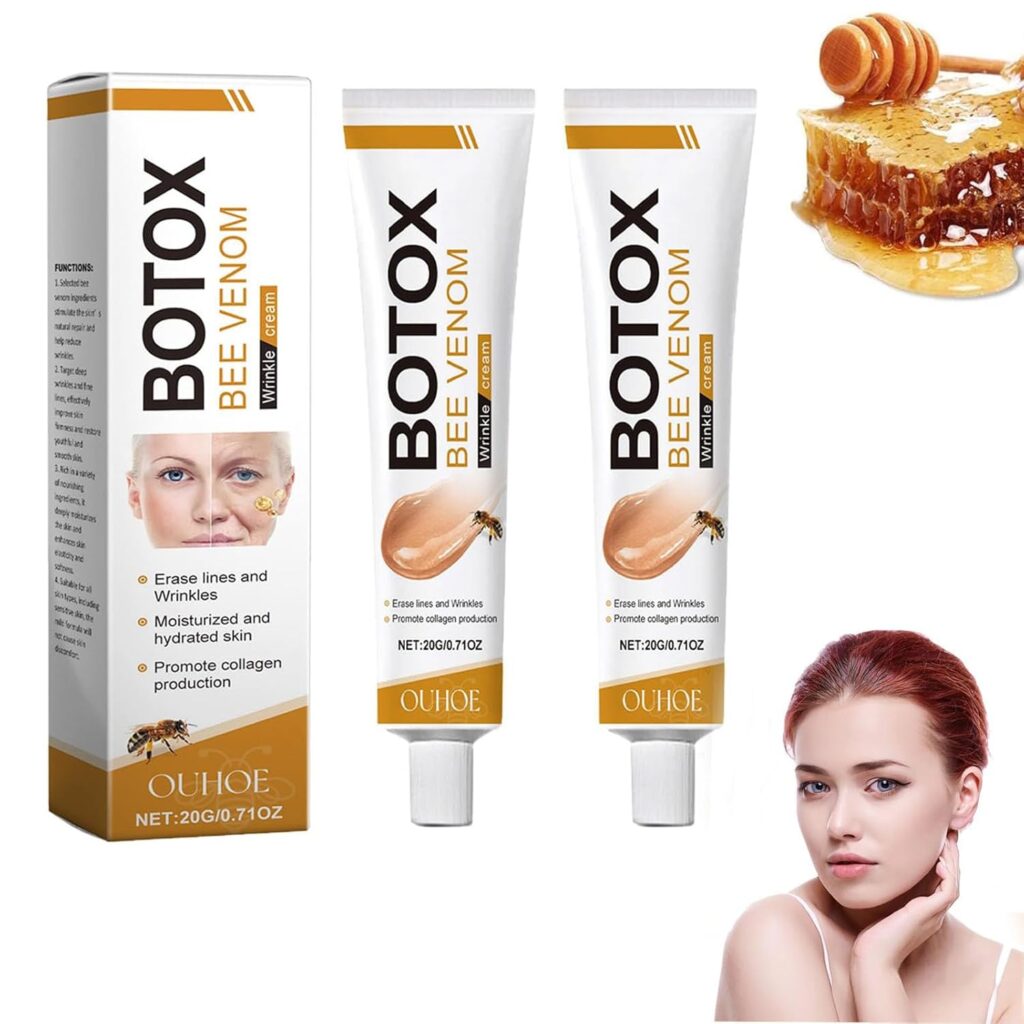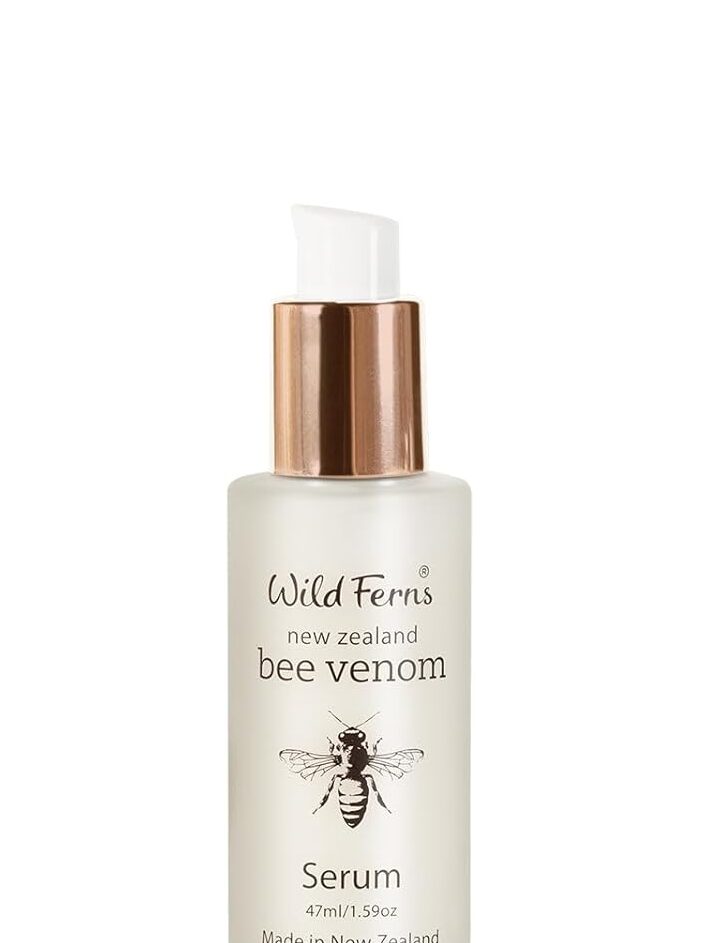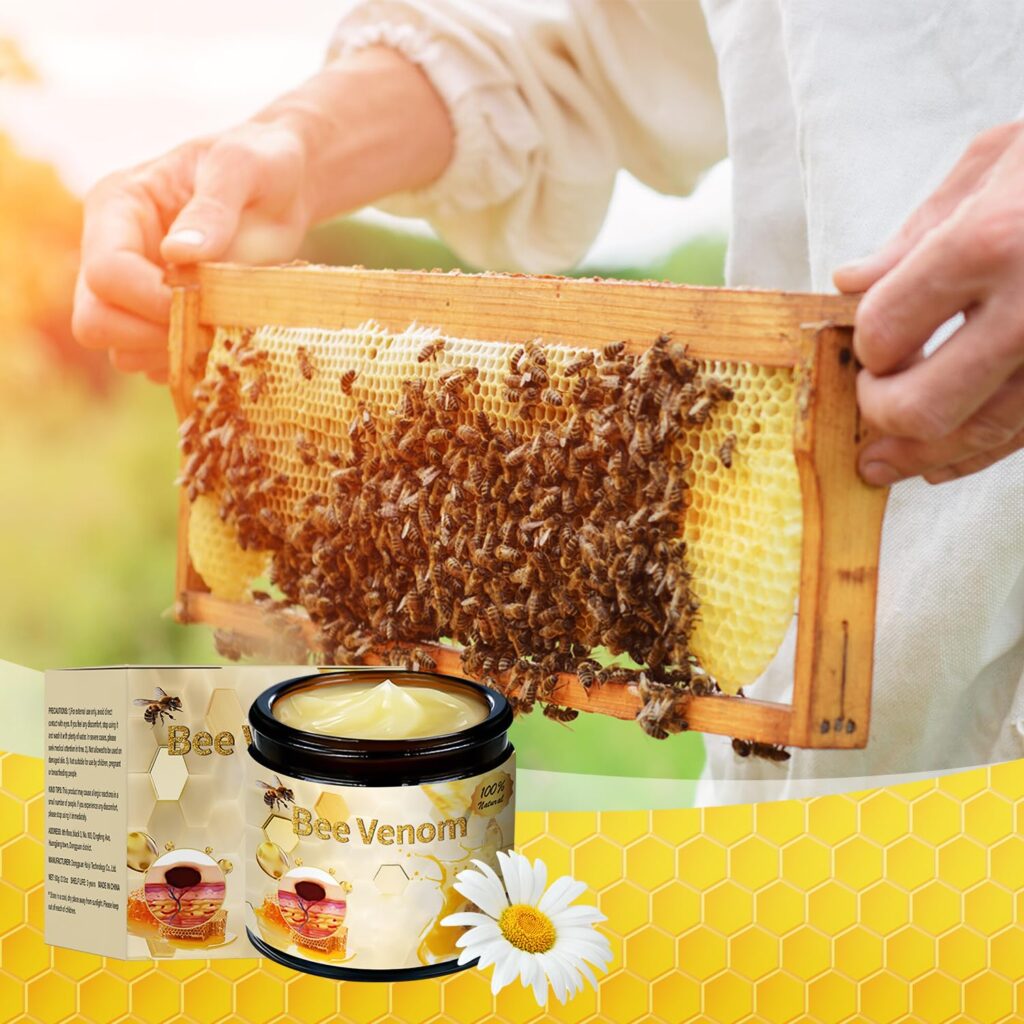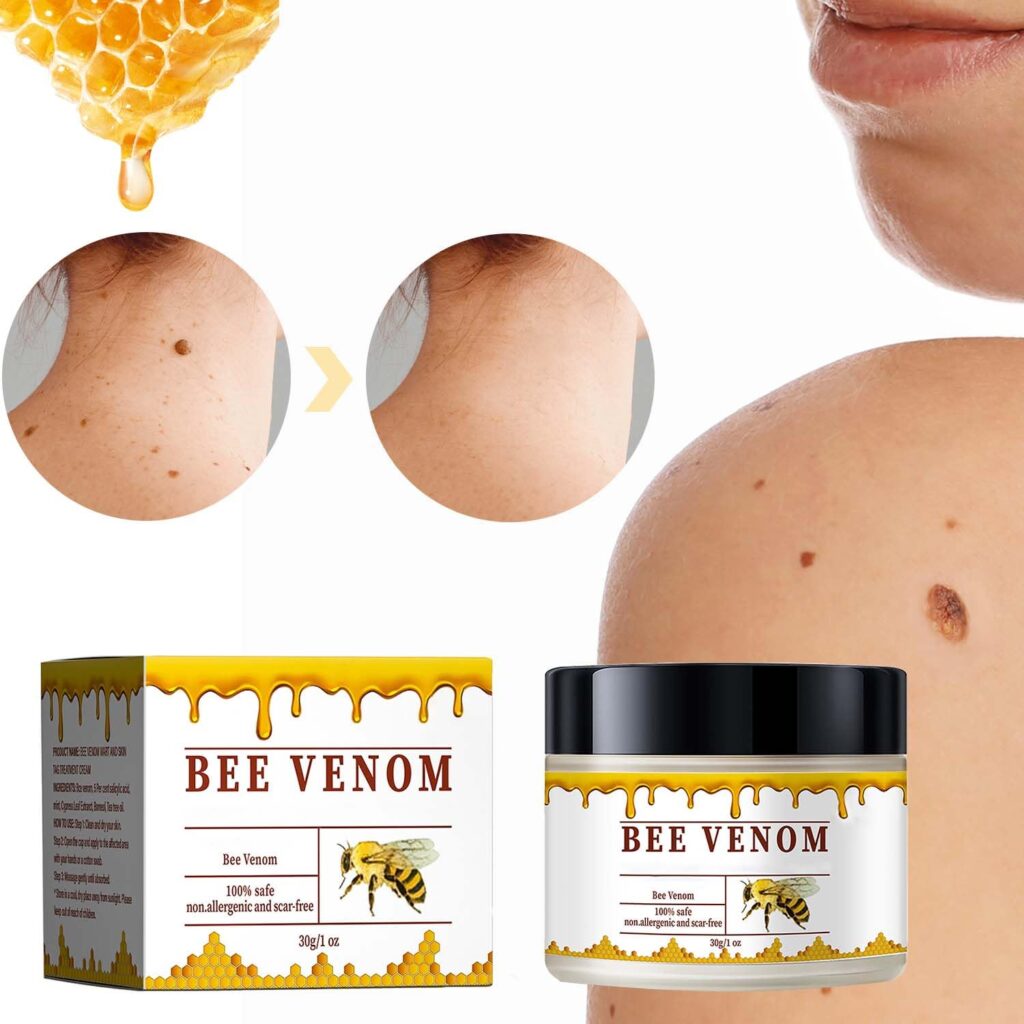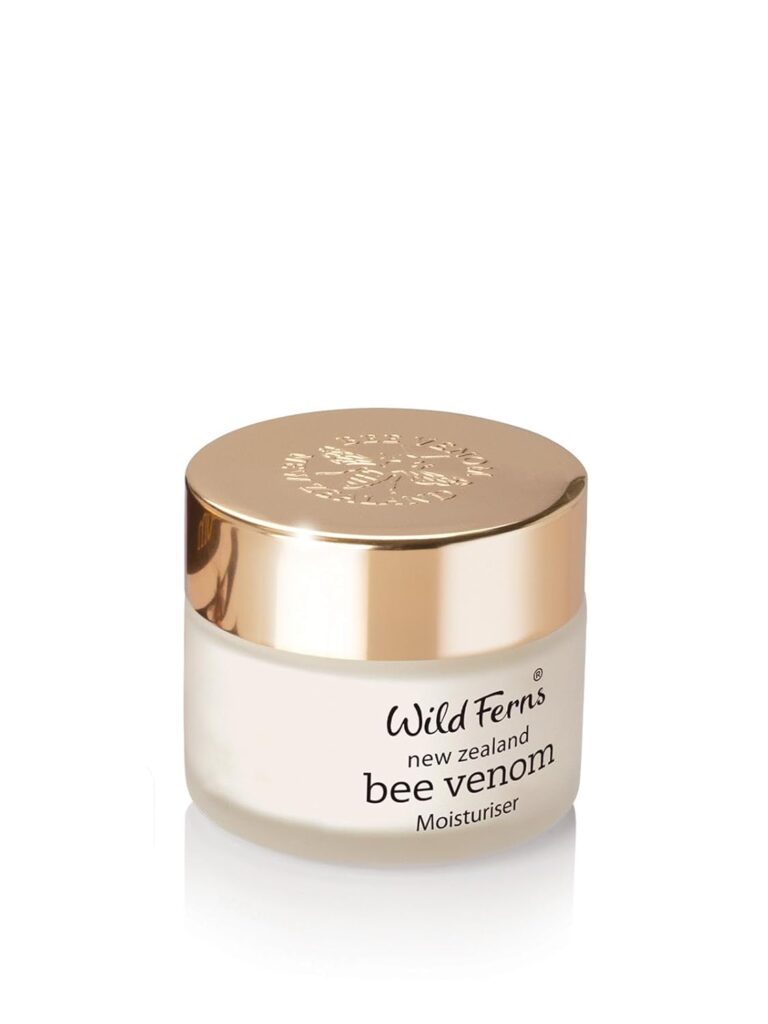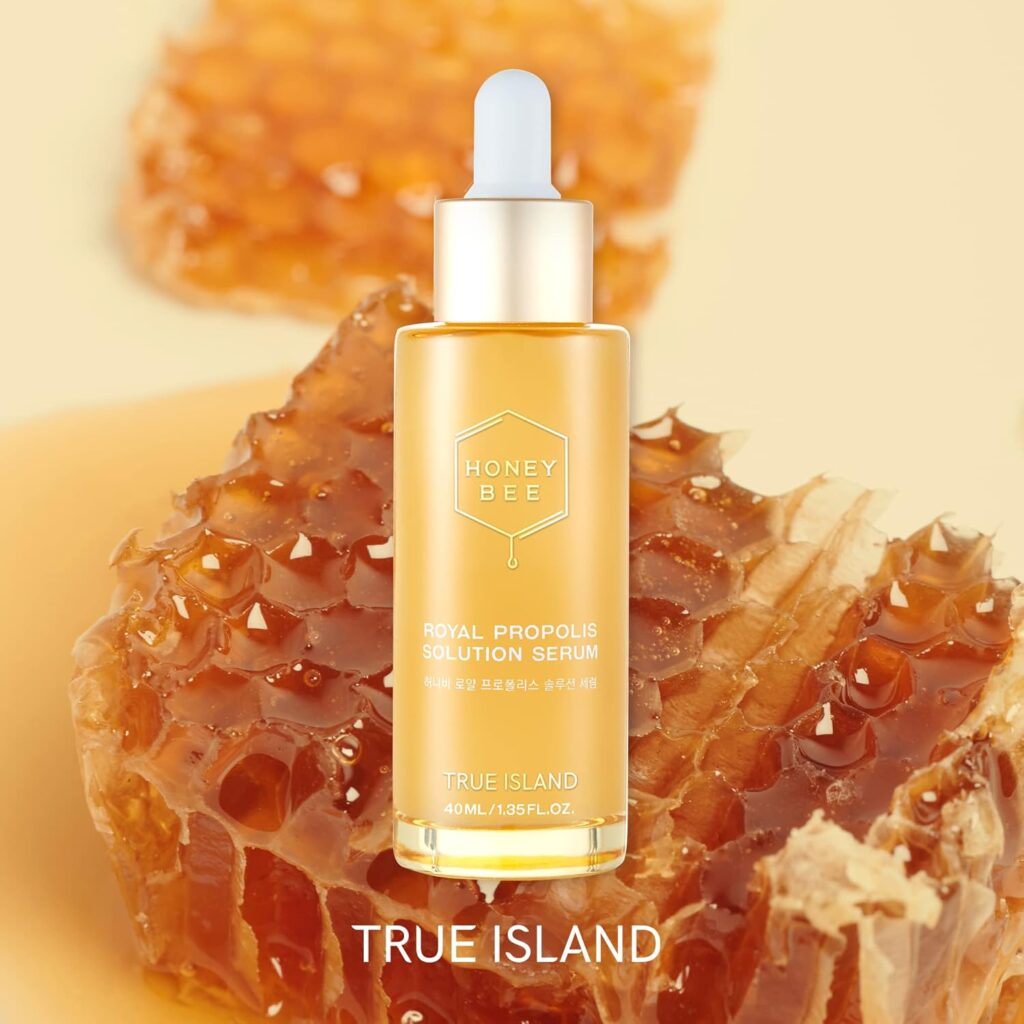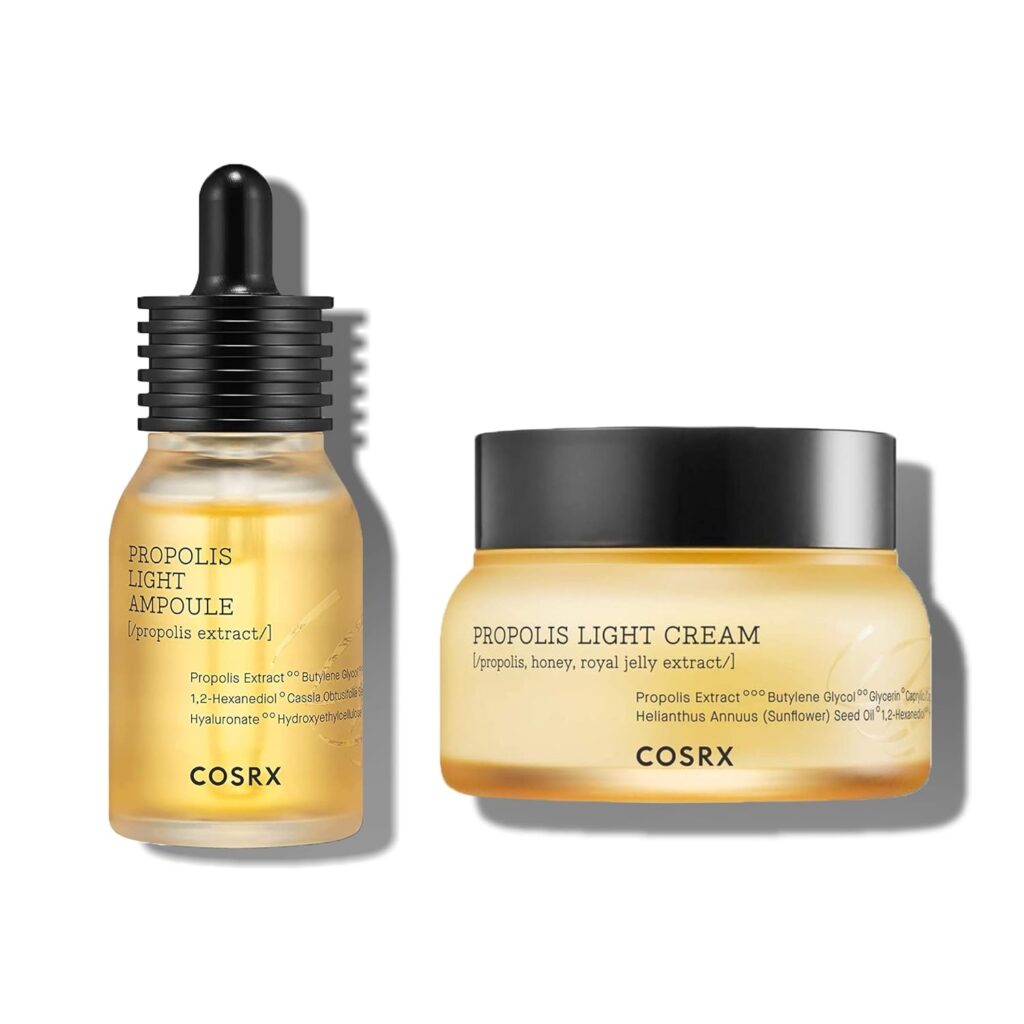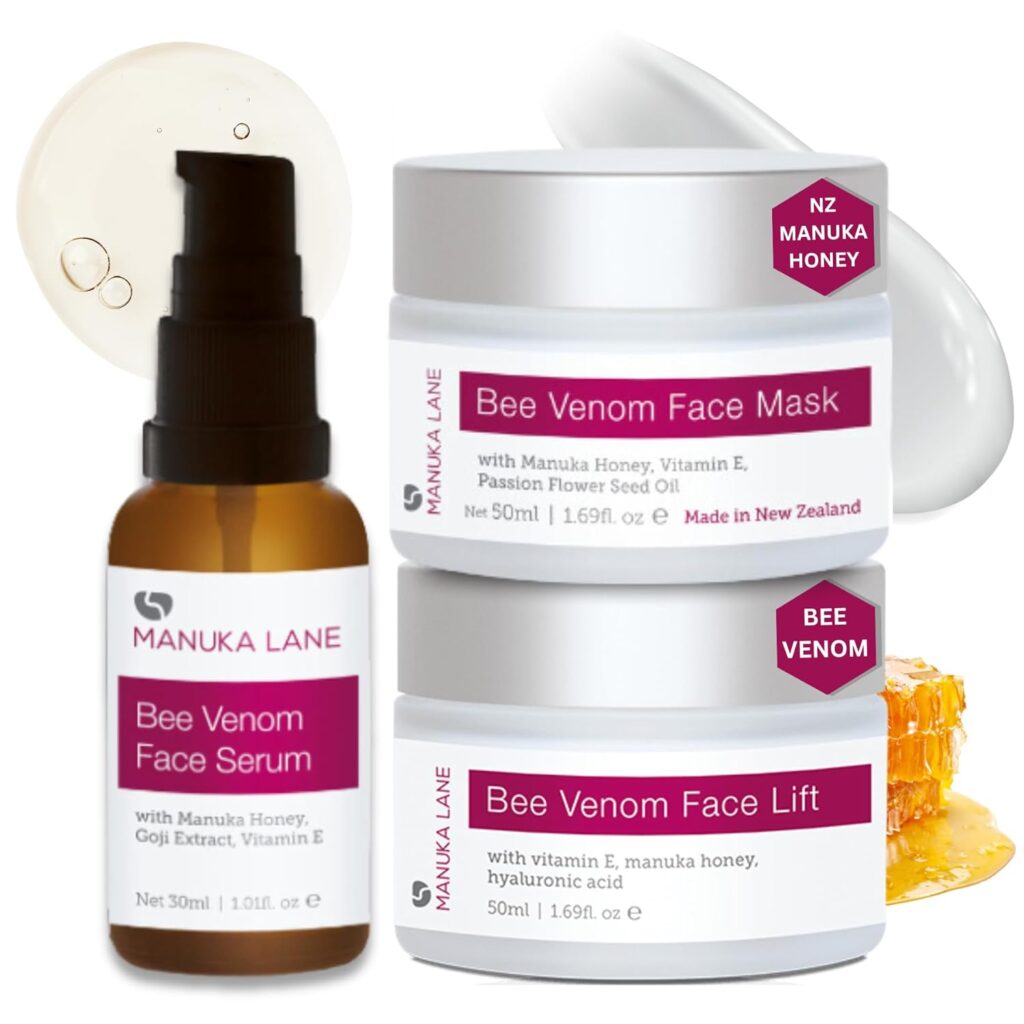The clash between bee venom and Botox in the anti-aging arena is particularly fascinating. Both promise to turn back the clock on our skin, but their approaches couldn’t be more different.
Here are the buzz surrounding these treatments and uncover which might be the queen bee of anti-aging such as the Bee Venom by GSHLGAO specifically designed to lift, tighten, and rejuvenate skin, reducing the appearance of fine lines and wrinkles for a smoother, more youthful complexion.
One 96 percent natural bee venom serum found on Amazon, Wild Ferns New Zealand Bee Venom Serum with Manuka Honey 80+ also contains royal jelly which is noted as humanely harvested.
The Science Behind the Sting
Bee Venom: Nature’s Anti-Aging Weapon
Bee venom, scientifically known as apitoxin, is a complex mixture of compounds that bees use as a defense mechanism. When Bee Venom Cream is applied to the skin, it creates a mild, controlled inflammatory response.
This clever biological trick fools your skin into thinking it’s been stung, triggering a cascade of healing processes.
The star player in bee venom is melittin, a peptide with powerful anti-inflammatory and antimicrobial properties. Melittin stimulates the production of collagen and elastin, two crucial proteins that keep our skin firm and supple.
As we age, our natural production of these proteins slows down, leading to sagging skin and wrinkles.
Bee venom essentially gives our skin a wake-up call, encouraging it to amp up it’s natural rejuvenation processes. Below is just one of Amazon’s choice Bee Venom Treatment and Repair for all parts of the body enriched with natural herbal extracts like tea tree oil and safe for all sensitive skin types to aid in accelerating skin repair.
Botox: The Muscle-Freezing Phenomenon
Botox, short for Botulinum toxin, is a neurotoxin derived from the bacterium Clostridium botulinum. It works by temporarily paralyzing the muscles responsible for creating wrinkles.
When injected into specific facial areas, Botox blocks nerve signals to the muscles, preventing them from contracting.
This relaxation of the muscles smooths out existing wrinkles and prevents new ones from forming.
The effects of Botox are more immediate and dramatic compared to bee venom. Within a few days of treatment, patients typically see a significant reduction in the appearance of fine lines and wrinkles, particularly in areas like the forehead and around the eyes.
From Hive to Face: Practical Applications
Bee Venom: The DIY Approach
Incorporating bee venom into your skincare routine is surprisingly straightforward. It’s typically found in creams, serums, and masks that can be applied at home.
The application process is painless and non-invasive, making it an attractive option for those who shy away from needles or more invasive procedures.
When using bee venom products, it’s crucial to start with a patch test to check for any allergic reactions. Once you’ve confirmed it’s safe for your skin, you can begin incorporating it into your daily routine.
Most bee venom products are designed to be used once or twice daily, typically after cleansing and before moisturizing. Or use Wild Ferns bee venom moisturizer that is Amazon’s choice when it comes to 99% natural and highly recommended.
One of the biggest challenges with bee venom products is ensuring their efficacy. The concentration and quality of bee venom can vary widely between products, so it’s crucial to choose reputable brands that are transparent about their sourcing and formulation processes.
Look for products that list the percentage of bee venom in their ingredients and opt for people who have higher concentrations for more noticeable results.
Botox: The Professional Touch
Botox requires a trip to a qualified professional. The treatment involves injections directly into the targeted muscles, which can cause some discomfort.
While the procedure is quick, typically taking only about 10 minutes, it does come with a higher price tag and the need for periodic touch-ups.
The process begins with a consultation where you’ll talk about your goals and concerns with your practitioner. They’ll assess your facial structure and muscle movement to decide the best injection sites and dosage.
The actual treatment involves several small injections into the targeted areas.
Most people describe the sensation as a slight pinch or sting.
Results from Botox typically start to appear within 3-5 days, with full effects visible after about two weeks. The effects usually last 3-6 months, after which you’ll need to return for another treatment to maintain the results.
The Sting of Reality: Potential Risks and Side Effects
Bee Venom: Nature’s Double-Edged Sword
The most significant concern with bee venom is the risk of allergic reactions, particularly for people who have known bee allergies. Even for those without allergies, bee venom can cause skin irritation, redness, and swelling.
In rare cases, it can lead to more severe reactions like anaphylaxis.
To minimize these risks, always perform a patch test before using any new bee venom product. Apply a small amount to the inside of your wrist and wait 24 hours to check for any adverse reactions.
If you experience any severe symptoms like difficulty breathing or swelling of the face or throat, seek medical attention immediately.
Long-term use of bee venom products is still being studied, and there’s limited data on potential added effects. Some users report increased skin sensitivity over time, so it’s important to listen to your skin and adjust usage accordingly.
Botox: The Precision Paradox
Botox, while generally considered safe when administered by a qualified professional, comes with it’s own set of potential side effects. The most common include bruising, swelling, and redness at the injection sites.
These typically resolve within a few days.
More serious, though rare, side effects can include temporary drooping of the eyelids or eyebrows if the toxin spreads to unintended muscles. There’s also a small risk of the toxin spreading to other areas, potentially causing muscle weakness or other unwanted effects.
To minimize these risks, it’s crucial to only receive Botox treatments from licensed, experienced practitioners. Follow all pre and post-treatment instructions carefully, and report any unusual symptoms to your provider immediately.
Adapting to Your Skin’s Needs
Bee Venom: The Versatile Virtuoso
One of the advantages of bee venom products is their versatility. They can be easily incorporated into existing skincare routines and combined with other active ingredients for enhanced results.
For instance, pairing bee venom with Manuka honey can provide extra antibacterial and moisturizing benefits. One natural bee venom serum found on Amazon, Wild Ferns New Zealand Bee Venom Serum with Manuka Honey 80+ also contains royal jelly.
Bee venom works particularly well when combined with other natural anti-aging ingredients like propolis, royal jelly, and hyaluronic acid. This synergistic approach can help address many skin concerns simultaneously, from fine lines and wrinkles to hydration and overall skin health. True Island Honey Bee Royal Propolis Solution Serum is another Amazon Choice product to consider.
As your skin adapts to bee venom, you may find that you can increase the frequency of use or move to products with higher concentrations. With over 5000 reviews the COSRX Glowing Honey Skin Duo- Propolis 73.5% Ampoule + Propolis 64.5% Cream is an Amazon favorite. Always listen to your skin and adjust accordingly.
Some people find that alternating bee venom products with other anti-aging treatments provides the best results. For more bee skin care essentials to promote your flawless skin journey refer to Review of Bee Skincare: Nature’s Secret to Radiant Skin.
Botox: The Targeted Approach
While Botox is less flexible in it’s application, it can be tailored to target specific areas of concern. The dosage and injection sites can be adjusted to achieve a more natural look or to address particular wrinkles more aggressively.
Over time, you and your practitioner may refine your treatment plan based on your results and goals. Some people find that they need less frequent treatments as their muscles become “trained” to relax.
Others may choose to mix Botox with other treatments like dermal fillers for a more comprehensive approach to facial rejuvenation.
Beyond the Basics: Advanced Anti-Aging Strategies
Bee Venom: The Natural Synergy
As you become more familiar with bee venom products, you can start to explore more advanced anti-aging strategies. This might involve experimenting with different product formulations or combining bee venom treatments with other natural anti-aging ingredients. Or as one of Amazon’s higher reviewed is the New Zealand Bee Venom Complete Skin Care Regimen which includes Bee Venom Face Mask, Bee Venom Face Serum, and Bee Venom Face Lift all safely derived, and natural ingredients
For example, you might try a bee venom serum in the morning followed by a propolis-infused night cream. Or you could alternate days between bee venom and vitamin C serums to target both collagen production and skin brightening.
Some skincare enthusiasts even create their own DIY bee venom masks by mixing high-quality bee venom powder with natural ingredients like raw honey, aloe vera gel, or green tea extract. While this can be a fun and effective approach, it’s crucial to be extremely careful with measurements and always patch test your creations.
Some practitioners are exploring the use of “micro-Botox,” which involves injecting very small amounts of the toxin into the skin as opposed to the muscles. This technique aims to improve skin texture and reduce pore size without affecting facial expressions.
Another advanced approach is combining Botox with other non-invasive treatments like microneedling or radiofrequency therapy. These combination treatments can address many signs of aging simultaneously, targeting not just wrinkles and skin texture, tone, and firmness.
For those seeking a more holistic approach, some practitioners are incorporating Botox into broader facial rejuvenation plans that include lifestyle changes, skincare routines, and complementary treatments like facial acupuncture or lymphatic drainage massage.
Putting Theory into Practice: Your Anti-Aging Action Plan
Ready to give these treatments a try? Here’s a step-by-step guide to incorporating bee venom or Botox into your anti-aging routine:
- Research and Consult: Gather information from reputable sources and talk to a dermatologist or skincare professional to decide which treatment is best suited for your skin type and concerns.
Consider factors like your age, skin condition, budget, and comfort level with different treatment approaches.
- For Bee Venom:
- Start with a patch test to check for allergic reactions. Apply a small amount of the product to the inside of your wrist and wait 24 hours.
- Begin with a low concentration product and gradually increase as your skin adjusts. Look for serums or creams with 1-3% bee venom to start.
- Apply the product as directed, typically once or twice daily. Most people find it works best applied after cleansing and toning, but before moisturizing.
- Be patient – results may take several weeks to become noticeable. Take progress photos every two weeks to track changes objectively.
- For Botox:
- Choose a qualified, experienced practitioner. Look for board-certified dermatologists or plastic surgeons with extensive experience in Botox injections.
- Discuss your goals and expectations during the consultation. Be honest about your medical history and any medications you’re taking.
- Follow all pre and post-treatment instructions carefully. This may include avoiding certain medications or supplements before treatment and refraining from strenuous exercise or lying down for several hours after.
- Schedule follow-up appointments as recommended by your practitioner. Most people need treatments every 3-6 months to maintain results.
- Monitor Results: Keep track of any changes in your skin’s appearance and texture.
Take before and after photos in consistent lighting to help you objectively assess the treatment’s effectiveness.
- Adjust as Needed: If you’re not seeing the desired results, don’t be afraid to try a different product formulation or talk about adjusting your Botox treatment plan with your practitioner.
Remember, skincare is highly person, and what works for one person may not work for another.
The Role of Lifestyle in Anti-Aging
While bee venom and Botox can be powerful tools in your anti-aging arsenal, it’s crucial to remember that they’re just part of the equation. A holistic approach to skin health and aging involves several key lifestyle factors:
Nutrition for Radiant Skin
What you put into your body has a significant impact on your skin’s appearance. A diet rich in antioxidants, healthy fats, and hydrating foods can support your skin’s natural rejuvenation processes.
Some skin-loving foods to incorporate into your diet include:
- Berries (blueberries, strawberries, raspberries) for their high antioxidant content
- Fatty fish like salmon for omega-3 fatty acids
- Avocados for healthy fats and vitamin E
- Leafy greens for vitamins and minerals
- Green tea for it’s anti-inflammatory properties
Hydration: The Foundation of Youthful Skin
Proper hydration is crucial for maintaining plump, youthful-looking skin. Aim to drink at least 8 glasses of water a day, and consider incorporating hydrating foods like cucumbers, watermelon, and celery into your diet.
Sleep: Your Skin’s Natural Reset Button
During sleep, your body goes into repair mode, producing collagen and repairing cellular damage. Aim for 7-9 hours of quality sleep each night.
Consider using a silk pillowcase to reduce friction and prevent sleep lines.
Sun Protection: The Ultimate Anti-Aging Strategy
No anti-aging routine is finish without proper sun protection. UV rays are responsible for up to 80% of visible skin aging.
Use a broad-spectrum sunscreen with at least SPF 30 daily, even on cloudy days or when you’re indoors.
Stress Management: Your Skin’s Best Friend
Chronic stress can speed up the aging process, leading to inflammation and breakdown of collagen. Incorporate stress-reducing activities into your routine, such as meditation, yoga, or regular exercise.
The Future of Anti-Aging: What’s on the Horizon?
While bee venom and Botox continue to hold their ground, several exciting developments are on the horizon:
Stem Cell Therapy
Researchers are exploring the use of stem cells in skincare, with the potential to regenerate damaged skin and stimulate collagen production. While still in it’s early stages, stem cell-based treatments could alter anti-aging skincare in the coming years.
Nanotechnology
The use of nanoparticles in skincare products is gaining traction. These tiny particles can penetrate deeper into the skin, delivering active ingredients more effectively.
This could lead to more potent and targeted anti-aging treatments.
Personalized Skincare
Advances in genetic testing and AI-powered skin analysis are paving the way for truly personalized skincare regimens. In the future, we may see anti-aging treatments tailored to our person genetic makeup and specific skin concerns.
Microbiome-Focused Treatments
As we learn more about the skin’s microbiome, treatments that target and support beneficial skin bacteria are likely to become more prevalent. These could help maintain skin health and slow the aging process from the microscopic level up.
Ethical Considerations in Anti-Aging Treatments
As we explore different anti-aging options, it’s important to consider the ethical implications of our choices:
Animal Testing
Many consumers are becoming more conscious of animal testing in the beauty industry. While Botox has historically been tested on animals, some companies are now exploring alternative testing methods.
Bee venom products can be produced without harming bees, but it’s important to research brands to confirm they use ethical harvesting practices. Take a closer look at how bee venom can be extracted without harming or killing the bee.
Environmental Impact
Consider the environmental footprint of your skincare choices. Look for brands that use sustainable packaging and responsibly sourced ingredients.
Some bee venom products are part of broader bee conservation efforts, which can be a positive environmental choice.
Promoting Realistic Beauty Standards
While anti-aging treatments can boost confidence and self-esteem, it’s crucial to maintain a healthy perspective on aging. Embracing the natural aging process while taking care of your skin can lead to a more balanced and positive approach to beauty. Wild Fern’s Bee Venom has one of the highest % of natural products such as seen on Amazon’s highly reviewed Wild Ferns Night Creme sourced from New Zealand from a small family run company.

Key Takeaways
- Bee venom stimulates collagen production through controlled inflammation, while Botox paralyzes muscles to reduce wrinkles.
- Bee venom products can be applied at home, while Botox needs professional administration.
- Both treatments carry potential risks, including allergic reactions for bee venom and injection-related complications for Botox.
- Results from bee venom products are generally more gradual, while Botox offers more immediate effects.
- Consistency and patience are essential for success with either treatment.
- A holistic approach to anti-aging includes proper nutrition, hydration, sleep, sun protection, and stress management.
- The future of anti-aging skincare may include stem cell therapy, nanotechnology, and personalized treatments.
- Consider the ethical implications of your skincare choices, including animal testing and environmental impact.
People Also Asked
What is bee venom therapy?
Bee venom therapy involves applying bee venom to the skin or injecting it into specific points on the body. It’s used for various purposes, including anti-aging and pain relief.
How long do Botox injections last?
Botox injections typically last 3-6 months, after which the effects gradually wear off and treatment needs to be repeated to maintain results.
Can bee venom cause allergic reactions?
Yes, bee venom can cause allergic reactions, especially in people with known bee allergies. Always perform a patch test before using bee venom products.
Is Botox safe for long-term use?
Botox is generally considered safe for long-term use when administered by a qualified professional. However, long-term effects are still being studied.
How often should I use bee venom products?
Most bee venom skincare products are designed to be used daily or twice daily. Always follow the specific instructions for the product you’re using.
Can Botox be used for purposes other than wrinkle reduction?
Yes, Botox has various medical applications beyond cosmetic use, including treatment for migraines, excessive sweating, and muscle spasms.
Are there any natural choices to Botox?
Several natural ingredients are marketed as Botox choices, including argireline, hibiscus, and certain peptides. However, their effects are generally more subtle than Botox.
How does bee venom compare to other natural anti-aging ingredients?
Bee venom is often considered more potent than many other natural anti-aging ingredients because of it’s ability to stimulate collagen production and create a mild inflammatory response.
What is Beetox?
Can men use bee venom products or get Botox?
Absolutely! Both bee venom products and Botox are suitable for men and women.
Men are increasingly using these treatments for anti-aging purposes.
How much do Botox treatments typically cost?
The cost of Botox treatments varies widely depending on location and the number of areas treated. On average, treatments can range from $300 to $1000 per session.
For more bee skin care essentials to promote your flawless skin journey refer to Review of Bee Skincare: Nature’s Secret to Radiant Skin.
